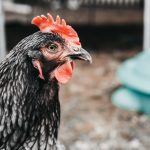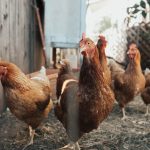Chicken farming in the United States has evolved significantly in recent decades, transitioning to large-scale industrial production methods focused on efficiency and cost-effectiveness. This shift has resulted in the widespread adoption of intensive farming practices, including high-density housing and the use of antibiotics and growth promoters. While these methods have increased chicken meat production and reduced consumer costs, they have also sparked debates about animal welfare and the overall health of chickens.
In response to growing public concern, there has been increased attention on chicken welfare in the United States. Consumers, animal advocacy groups, and industry stakeholders have called for improvements in farming practices to enhance the ethical treatment and sustainability of chicken production. This has led to greater scrutiny of current methods and demands for increased transparency within the poultry industry.
The evolving landscape of chicken farming in the United States has prompted comparisons with practices in other countries and a closer examination of global welfare standards and regulations. This growing interest reflects a broader societal shift towards more conscious consumption and a desire for improved animal welfare practices in agriculture.
Table of Contents
- 1 Comparing chicken farming practices in other countries
- 2 Welfare standards and regulations for chickens in different countries
- 3 Differences in housing and living conditions for chickens
- 4 The impact of farming practices on chicken health and well-being
- 5 Consumer attitudes and demand for ethically raised chickens
- 6 Potential improvements for chicken farming practices in the United States
- 7 FAQs
Key Takeaways
- Chicken farming in the United States is a major industry, with a focus on efficiency and high production levels.
- Comparing chicken farming practices in other countries reveals a wide range of approaches, from intensive factory farming to more ethical and sustainable methods.
- Welfare standards and regulations for chickens vary greatly between countries, with some having strict guidelines and others having minimal oversight.
- Differences in housing and living conditions for chickens can have a significant impact on their health and well-being, with some systems providing more space and natural behaviors than others.
- Consumer attitudes and demand for ethically raised chickens are growing, indicating a potential shift towards more sustainable and humane farming practices.
Comparing chicken farming practices in other countries
Differences in Farming Methods
When comparing chicken farming practices in other countries to those in the United States, it becomes evident that there are significant differences in how chickens are raised and managed. In some European countries, for example, there is a greater emphasis on free-range and organic farming methods, which prioritize outdoor access and natural living conditions for chickens. This stands in contrast to the intensive farming methods commonly used in the United States, where chickens are often raised in crowded indoor facilities with limited access to the outdoors.
Regulations and Priorities
In countries like Sweden and Switzerland, there are strict regulations in place to ensure that chickens are provided with ample space, natural light, and environmental enrichment to support their physical and psychological well-being. Additionally, these countries have banned the routine use of antibiotics and growth hormones in chicken farming, which has led to a greater focus on disease prevention and sustainable farming practices.
Implications for Animal Welfare and Food Safety
By contrast, the United States has been criticized for its reliance on antibiotics and growth-promoting additives, which have raised concerns about antibiotic resistance and the long-term health implications for both chickens and consumers. These differences highlight the need for a more comprehensive understanding of how chicken farming practices vary across different countries and the potential impact on animal welfare and food safety.
Welfare standards and regulations for chickens in different countries
The welfare standards and regulations that govern chicken farming vary widely from country to country. In the European Union, for example, there are strict regulations in place to ensure that chickens are provided with adequate space, environmental enrichment, and access to natural light. These regulations also prohibit the routine use of antibiotics for growth promotion and require that chickens be provided with outdoor access when raised under free-range or organic farming systems.
Additionally, the EU has implemented welfare labeling schemes that allow consumers to make informed choices about the chicken products they purchase based on the farming methods used. In contrast, the United States has fewer federal regulations governing chicken welfare, which has led to variations in farming practices across different states and producers. While some companies have voluntarily adopted welfare standards and certification programs, there is still a lack of consistency and transparency within the industry.
This has prompted calls for stronger regulations and oversight to ensure that chickens are raised in a manner that prioritizes their physical and psychological well-being. As consumer awareness and demand for ethically raised chickens continue to grow, there is an opportunity to learn from the welfare standards and regulations implemented in other countries to inform potential improvements in the United States.
Differences in housing and living conditions for chickens
The housing and living conditions for chickens vary significantly between countries, reflecting different farming practices and regulatory frameworks. In the United States, the majority of chickens are raised in large-scale indoor facilities known as concentrated animal feeding operations (CAFOs). These facilities are designed to maximize production efficiency, often resulting in overcrowded living conditions with limited space for movement and natural behaviors.
Additionally, many chickens in the US are raised on wire flooring, which can lead to foot injuries and discomfort. In contrast, some European countries have adopted alternative housing systems that prioritize outdoor access and natural living conditions for chickens. For example, free-range systems provide chickens with access to outdoor pasture areas during the day, while organic systems require that chickens have continuous outdoor access when weather conditions permit.
These systems aim to mimic natural behaviors and provide chickens with opportunities for exercise, foraging, and social interaction. By providing more space and environmental enrichment, these housing systems can support better physical health and psychological well-being for chickens compared to traditional intensive farming methods.
The impact of farming practices on chicken health and well-being
The impact of farming practices on chicken health and well-being is a critical consideration when evaluating different approaches to chicken farming. In the United States, intensive farming methods have been associated with a range of welfare issues for chickens, including high levels of stress, injuries, and behavioral abnormalities. The use of antibiotics and growth hormones has also raised concerns about the long-term health implications for both chickens and consumers.
Additionally, overcrowded living conditions can contribute to poor air quality and an increased risk of disease transmission within poultry facilities. In contrast, countries with stricter welfare regulations have seen improvements in chicken health and well-being as a result of more natural living conditions and disease prevention measures. For example, research has shown that providing chickens with outdoor access can reduce stress levels and promote healthier immune systems.
Furthermore, by limiting the use of antibiotics and focusing on disease prevention through improved hygiene and biosecurity measures, these countries have been able to reduce the prevalence of antibiotic-resistant bacteria in poultry production. These findings underscore the potential benefits of adopting more sustainable and welfare-focused farming practices to support better health outcomes for chickens.
Consumer attitudes and demand for ethically raised chickens

European Market Trends
In Europe, consumer demand for ethically raised chicken products has driven market growth for free-range and organic poultry products. This has incentivized producers to invest in alternative housing systems that prioritize outdoor access and natural living conditions for chickens. Additionally, labeling schemes that provide transparency about farming methods have empowered consumers to make informed choices about the chicken products they purchase.
US Market Trends
In the United States, there is also a growing interest in ethically raised chicken products, with some consumers willing to pay a premium for products that are certified as meeting higher welfare standards.
Industry Response
In response to this trend, some retailers and food service companies have committed to sourcing chicken products from producers that adhere to higher welfare standards and sustainable farming practices.
Potential improvements for chicken farming practices in the United States
In conclusion, there is an opportunity to learn from the experiences of other countries when considering potential improvements for chicken farming practices in the United States. By examining welfare standards, housing systems, and regulatory frameworks from around the world, it becomes evident that there are alternative approaches that prioritize animal welfare while also supporting sustainable production. As consumer demand for ethically raised chicken products continues to grow, there is an opportunity for the poultry industry to embrace more transparent and welfare-focused farming practices.
Potential improvements for chicken farming practices in the United States may include greater investment in alternative housing systems that provide chickens with outdoor access and natural living conditions. Additionally, there is a need for stronger federal regulations that ensure consistent welfare standards across all producers. By reducing reliance on antibiotics and growth hormones, improving living conditions, and promoting disease prevention measures, it is possible to support better health outcomes for chickens while also addressing consumer concerns about animal welfare and food safety.
Ultimately, by prioritizing ethical considerations within the poultry industry, it is possible to create a more sustainable and responsible approach to chicken farming in the United States.
If you’re interested in learning more about how other countries keep their chickens, you might want to check out this article on renting a chicken coop. It provides insight into different methods and practices for raising chickens in other parts of the world, which could offer valuable lessons for improving the welfare of chickens in our own country.
FAQs
What are the different ways that other countries keep their chickens?
Other countries may keep their chickens in a variety of ways, including free-range systems, organic systems, and conventional cage systems.
Do other countries have stricter regulations for chicken welfare than the United States?
Some countries may have stricter regulations for chicken welfare than the United States, including requirements for larger living spaces, access to outdoor areas, and restrictions on the use of certain antibiotics and hormones.
Are there any countries known for particularly high standards of chicken welfare?
Some countries, such as Sweden and Switzerland, are known for having particularly high standards of chicken welfare, including requirements for outdoor access, natural light, and enrichment materials.
What are some common practices in other countries for improving chicken welfare?
Common practices in other countries for improving chicken welfare may include providing outdoor access, using slower-growing breeds, and implementing animal welfare certification programs.
How do other countries address the issue of overcrowding in chicken farms?
Some countries may have regulations in place to address overcrowding in chicken farms, such as minimum space requirements per bird and restrictions on the use of overcrowded housing systems.
Meet Walter, the feathered-friend fanatic of Florida! Nestled in the sunshine state, Walter struts through life with his feathered companions, clucking his way to happiness. With a coop that’s fancier than a five-star hotel, he’s the Don Juan of the chicken world. When he’s not teaching his hens to do the cha-cha, you’ll find him in a heated debate with his prized rooster, Sir Clucks-a-Lot. Walter’s poultry passion is no yolk; he’s the sunny-side-up guy you never knew you needed in your flock of friends!







